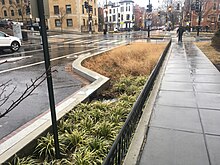
Bioswales are channels designed to concentrate and convey stormwater runoff while removing debris and pollution. Bioswales can also be beneficial in recharging groundwater.
Bioswales are typically vegetated, mulched, or xeriscaped.[1] They consist of a swaled drainage course with gently sloped sides (less than 6%).[2]: 19 Bioswale design is intended to safely maximize the time water spends in the swale, which aids the collection and removal of pollutants, silt and debris. Depending on the site topography, the bioswale channel may be straight or meander. Check dams are also commonly added along the bioswale to increase stormwater infiltration. A bioswale's make-up can be influenced by many different variables, including climate, rainfall patterns, site size, budget, and vegetation suitability.
It is important to maintain bioswales to ensure the best possible efficiency and effectiveness in removal of pollutants from stormwater runoff. Planning for maintenance is an important step, which can include the introduction of filters or large rocks to prevent clogging. Annual maintenance through soil testing, visual inspection, and mechanical testing is also crucial to the health of a bioswale.
Bioswales are commonly applied along streets and around parking lots, where substantial automotive pollution settles on the pavement and is flushed by the first instance of rain, known as the first flush. Bioswales, or other types of biofilters, can be created around the edges of parking lots to capture and treat stormwater runoff before releasing it to the watershed or storm sewer.
- ^ "Stormwater Best Management Practice: Grassed Swales" (PDF). Washington, D.C.: U.S. Environmental Protection Agency (EPA). December 2021. p. 3. EPA 832-F-21-031P.
- ^ Loechl, Paul M.; et al. (2003). Design Schematics for a Sustainable Parking Lot (PDF). Champaign, IL: US Army Corps of Engineers, Research and Development Center. Archived from the original (PDF) on 2010-06-02. Construction Engineering Research Laboratory. Document no. ERDC/CERL TR-03-12.